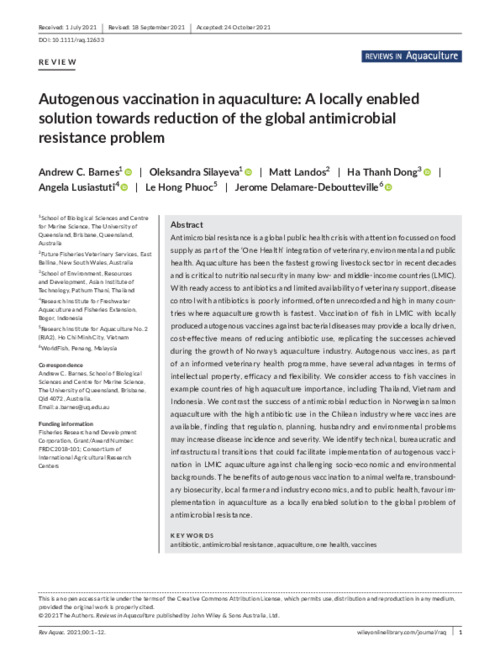Autogenous vaccination in aquaculture: A locally enabled solution towards reduction of the global antimicrobial resistance problem

Antimicrobial resistance is a global public health crisis with attention focussed on food supply as part of the ‘One Health’ integration of veterinary, environmental and public health. Aquaculture has been the fastest growing livestock sector in recent decades and is critical to nutritional security in many low- and middle-income countries (LMIC). With ready access to antibiotics and limited availability of veterinary support, disease control with antibiotics is poorly informed, often unrecorded and high in many countries where aquaculture growth is fastest. Vaccination of fish in LMIC with locally produced autogenous vaccines against bacterial diseases may provide a locally driven, cost-effective means of reducing antibiotic use, replicating the successes achieved during the growth of Norway's aquaculture industry. Autogenous vaccines, as part of an informed veterinary health programme, have several advantages in terms of intellectual property, efficacy and flexibility. We consider access to fish vaccines in example countries of high aquaculture importance, including Thailand, Vietnam and Indonesia. We contrast the success of antimicrobial reduction in Norwegian salmon aquaculture with the high antibiotic use in the Chilean industry where vaccines are available, finding that regulation, planning, husbandry and environmental problems may increase disease incidence and severity. We identify technical, bureaucratic and infrastructural transitions that could facilitate implementation of autogenous vaccination in LMIC aquaculture against challenging socio-economic and environmental backgrounds. The benefits of autogenous vaccination to animal welfare, transboundary biosecurity, local farmer and industry economics, and to public health, favour implementation in aquaculture as a locally enabled solution to the global problem of antimicrobial resistance.
Permalink
Date Available
Type
Publisher
ISSN
1753-5123,1753-5131
Copyright
CC-BY-4.0
Research Themes
Language